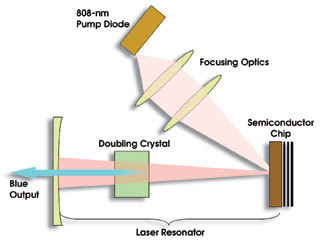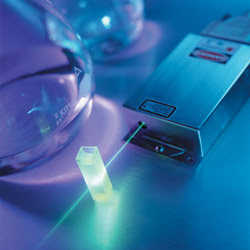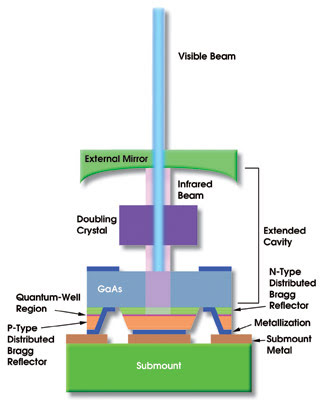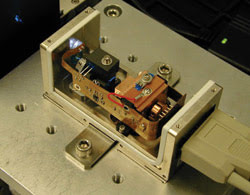The venerable air-cooled argon-ion laser appears to be the next target on solid-state technology's hit list.
Breck Hitz, Senior Technical Editor
Frequency-doubled diode lasers that produce blue light at or near 488 nm have emerged over the past couple of years, potentially affecting the multibillion-dollar instrumentation market based on the air-cooled argon-ion laser that has evolved over the past two decades.
Developed at Spectra-Physics in the early 1970s by a group led by John Goldsborough, the air-cooled argon-ion laser has found broad applications, including in the medical field, in graphics and in semiconductor inspection. Goldsborough, now retired, recently recalled that the first air-cooled ion laser was a prototype developed for a medical company’s cell sorter. Indeed, 30 years later, cell sorting has grown into a major application of the argon-ion laser.
Ion lasers also produce a green line at 514.5 nm, but that color has already been challenged by frequency-doubled neodymium lasers. What’s new is the recent emergence of frequency-doubled diode lasers that produce light at or near the 488-nm wavelength of the ion laser.
Tens of thousands, if not hundreds of thousands, of air-cooled argon lasers have been sold for flow cytometry, DNA sequencing, confocal microscopy and other analytical medical technologies that involve the fluorescence of a marker dye. FITC, one of the most effective dyes for a host of applications, has an absorption that is only a few nanometers wide, and the argon-ion laser’s 488-nm line falls squarely within it. Any device intended to displace the air-cooled argon laser from its dominance in medical instrumentation, therefore, must come very close to the latter’s 488-nm wavelength.
So why would one wish to replace an argon-ion laser with a solid-state device? The new lasers are more rugged and compact than their gas counterparts, but their main advantage may be their energy efficiency. An air-cooled ion laser consumes a kilowatt or more to produce 10 to 20 mW of blue light. Solid-state lasers can do the same job with a few tens of watts — or, in some cases, less than 10 W — of electrical input.
The power and pointing stability and the beam quality of solid-state lasers are competitive with those of argon lasers. The former also may have twice the approximately 10,000-hour lifetime expected from the latter, although adequate data to prove this do not yet exist.
The new lasers may cost more, but that is apparently acceptable in the marketplace. A rule of thumb seems to be that the market will support a price expansion as great as 50 percent in exchange for a rugged, compact and efficient solid-state package.
First designs
In 2001, Coherent Inc. in Santa Clara, Calif., introduced Sapphire (not to be confused with a Ti:sapphire laser), an optically pumped, frequency-doubled diode laser that uses an 808-nm pump laser to create a population inversion in a GaAs-based vertical-external-cavity surface-emitting laser (Figure 1).

Figure 1. Coherent Inc.’s Sapphire is an internally frequency-doubled, optically pumped diode laser.
The laser is defined by two mirrors: a glass, spherical mirror at one end of the resonator, and a distributed Bragg reflector that is fabricated into the semiconductor chip at the other end. Both mirrors are highly reflective at the lasing wavelength of 976 nm, and a nonlinear crystal — which the company declines to identify — inside the resonator provides output coupling by converting part of the circulating power to the second harmonic at 488 nm.
The laser consumes 30 to 60 W, most of which goes to a thermoelectric cooler that stabilizes the resonator, to produce 20 mW of 488-nm light. Another, somewhat larger model that produces 200 mW from less than 75 W of input was launched in 2002. The M2 value of the beam from both lasers is less than 1.1.

Figure 2. Sapphire’s 488-nm beam matches the wavelength of an argon-ion laser.
Although Coherent does not guarantee a lifetime specification on the laser, marketing director Paul Ginouves said that 20,000 hours is not an unreasonable figure. “That’s longer than the lifetimes of most instruments the lasers go into,” he said.
Another of the first designs, Protera from Novalux Inc. in Sunnyvale, Calif., is based on the company’s extended-cavity surface-emitting laser that avoids the current crowding that limits the output of conventional vertical-cavity surface-emitting lasers. The three-mirror resonator enables a higher degree of mode control than a two-mirror Fabry-Perot resonator (Figure 3). In this device, the KNbO3 doubling crystal is inside the resonator. Among the most efficient of the 488-nm lasers, Protera produces 15 mW at 488 nm from less than 5 W of electrical input.

Figure 3. Novalux Inc.’s Protera is an internally doubled, three-mirror diode laser.
The M2 of its 15-mW beam is less than 1.2, and the expected lifetime is greater than 20,000 hours. The company also offers a 5-mW model with packaging and specifications similar to the 15-mW version.
Although the semiconductor laser was designed to emit at 980 nm for the telecom market, Novalux President and CEO Jeff Cannon said that there is no penalty for pushing the wavelength to 976 nm so that it subsequently can be doubled to 488 nm (Figure 4). In fact, he said, the company plans to use the concept to create a line of lasers with output from the violet to the infrared.

Figure 4. Protera produces 15 mW of 488-nm light from 5 W of electrical input.
Both Coherent and Novalux lasers use intracavity frequency doubling to generate the second harmonic of the 976-nm diode-laser radiation. The advantage of intracavity doubling over external doubling is higher conversion efficiency. Second-harmonic conversion efficiency is proportional to the fundamental (i.e., infrared) power, and intracavity powers in low-gain lasers are typically 40 to 100 times as great as the power that emerges in the beam, so intracavity doubling is much more efficient than extracavity doubling. The second-harmonic power extracted from an internally doubled laser can often be 50 to 80 percent of the optimally coupled fundamental power available from the laser. The disadvantage of intracavity doubling, however, is that it couples the complexity of a the nonlinear process with that of a intracavity dynamics, making the laser more complex.
Historically, continuous-wave lasers have been internally doubled because the conversion efficiency of doing so externally was too small to be practical. In recent years, however, the advent of quasi-phase-matching in highly nonlinear crystals has boosted the external conversion efficiency to the point where it is commercially feasible.
Phase matching
In normal (birefringent) phase matching, the crystal’s birefringence compensates for specular dispersion, so the fundamental and second-harmonic waves “see” the same refractive index and propagate through the crystal at the same velocity.
In quasi-phase-matching, the two waves are allowed to propagate at different velocities, but the phase mismatch is periodically reversed so that phase matching can occur independent of the propagation direction or the crystal birefringence. The advantage is twofold: A larger nonlinear coefficient can be utilized, and phase matching can occur outside the normal wavelength region that is allowed by birefringent phase matching.
What’s next?
Picarro (formerly Informed Diagnostics and also in Sunnyvale) plans to enter the market in October with its blue laser. As with several other companies, Picarro will not disclose how the laser is frequency-doubled, but marketing director Tom Steele did say that the doubling crystal is external to the laser resonator and that there is no resonant enhancement of the second-harmonic generation.
He emphasized the laser’s longevity and said that he expects the design to achieve a mean time to failure of 20,000 hours.
Based on the company’s telecom-qualified laser diode, the 488-nm laser will be available in 10- and 20-mW models, both featuring a beam with an M2 of less than 1.2 and a wavelength tolerance within 0.5 nm. The 20-mW model will consume less than 30 W of electrical input. Designed specifically to compete with Coherent’s laser, the Picarro unit’s laser head is sized identically to Sapphire’s own 125 × 70 × 34-mm package.
The Chromalase 488 produced by Blue Sky Research in Milpitas, Calif., also is scheduled for an October release. Company spokesman Chris Gladding declined to discuss the laser’s frequency doubling in detail, but he said that the crystal is outside the laser cavity. The device will produce 20 mW at 488 nm from less than 10 W of electrical input, will boast an M2 of less than 1.2 and will house the power supply, control electronics and laser head in a 160 × 70 × 25-mm package.
JDS Uniphase Corp. of San Jose, Calif., a leading manufacturer of air-cooled argon lasers, is developing a solid-state blue laser and plans to have a product available before the end of the year. The wavelength of the 10- to 20-mW laser output will be specified as 490 nm, plus or minus “a few” nanometers, according to product manager Scott DeMange. One of the few companies willing to discuss its approach to external frequency doubling, JDS uses quasi-phase-matching to obtain “very good” — perhaps in excess of 10 percent — single-pass conversion efficiency, he said. The laser head also will be sized as a drop-in replacement for Coherent’s Sapphire.
Spectra-Physics of Mountain View, Calif., another leading manufacturer of air-cooled ion lasers, is developing a 488-nm solid-state laser, but CEO Steve Sheng declined to reveal any details. “All I can say is that it will be externally doubled,” he said.
Other companies in the market include Torsana Laser Technologies in Skodsborg, Denmark, which offers the StarBright 488 with 10 mW of blue power from 40 W of electrical input. The externally frequency-doubled laser produces an output beam whose M2 is specified as less than 2. Rainbow Photonics’ BluePoint 488 is available in 2- and 5-mW models, but the Zurich, Switzerland, company declined to disclose technical details. Munich, Germany-based Toptica Photonics offers a large, solid-state, tunable 488-nm laser for laboratory applications.
Two other European firms take a different approach to achieve near-488-nm light from solid-state lasers. Guided Color Technologies in Jena, Germany, offers 10 mW at 491 nm from an up-converted fiber laser housed in a 125 × 66 × 62-mm package. Two pump photons from an infrared diode laser are absorbed to create a population inversion on an excited level that releases a 491-nm photon when it decays.
Lumics GmbH of Berlin expects to introduce a similar up-converted fiber laser in October or November, according to marketing director George Schaefer. The company’s laser will produce 10 mW at 491 nm in a beam with an M2 of less than 1.1, he said.
Reports of death premature
And what does Goldsborough think about these new solid-state lasers? “I was really impressed,” he said, referring to the devices displayed at a recent US trade show. “It’s such a small, efficient package.”
Nevertheless, the air-cooled ion laser is not likely to be obsolete anytime soon. As with the HeNe laser, it always will have applications. JDS Uniphase’s Bob Matsuba, for example, pointed out that there are many applications for multiline lasers, and in those cases, the ion laser still can compete economically with single-line, frequency-doubled semiconductor lasers.